Perioperative Nursing: ACORN Standards, Biological Hazards, and Safety
VerifiedAdded on 2021/04/17
|10
|2588
|151
Report
AI Summary
This report examines the biological hazards faced by perioperative nurses, including exposure to blood, body fluids, and sharp objects, which can lead to infections like HIV and hepatitis. It analyzes the standards set by the Australian College of Operating Room Nurses (ACORN) to mitigate these risks, focusing on staff and patient safety, professional practice, asepsis, equipment, and management. The report reviews relevant literature, including research articles from the past five years, and discusses the implications of ACORN standards in the author's practice setting, highlighting the importance of personal protective equipment and proper training. The report concludes by emphasizing the need for comprehensive training programs and the implementation of smoke-free operating theaters to ensure the safety of perioperative nurses and improve compliance with ACORN standards, ultimately aiming to minimize the risk of biological hazards in the surgical environment. The report also highlights the importance of risk assessment and management systems within healthcare facilities to monitor and address the occurrence of biological hazards, with recommendations for improved training and education to enhance the protection of perioperative personnel.
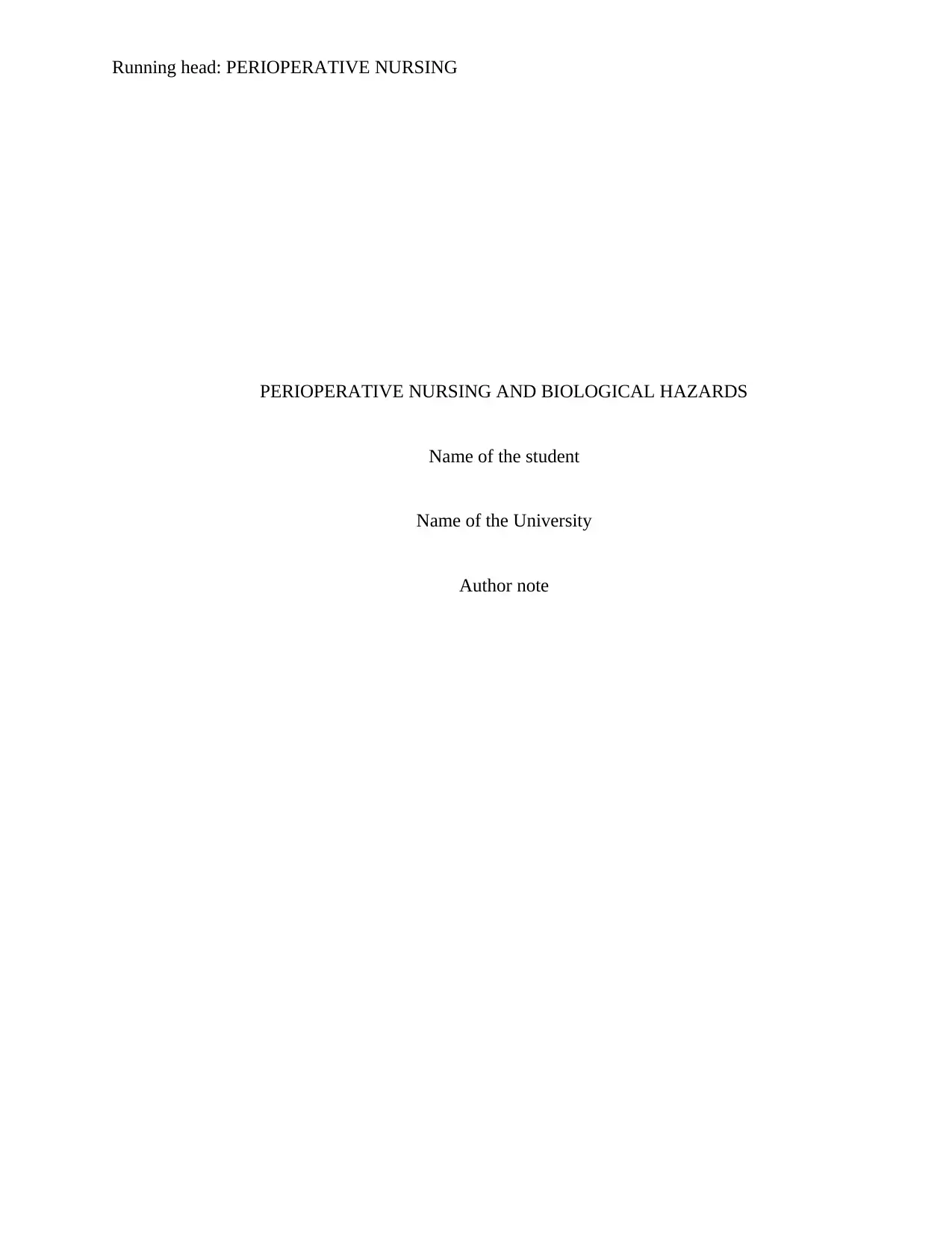
Running head: PERIOPERATIVE NURSING
PERIOPERATIVE NURSING AND BIOLOGICAL HAZARDS
Name of the student
Name of the University
Author note
PERIOPERATIVE NURSING AND BIOLOGICAL HAZARDS
Name of the student
Name of the University
Author note
Paraphrase This Document
Need a fresh take? Get an instant paraphrase of this document with our AI Paraphraser
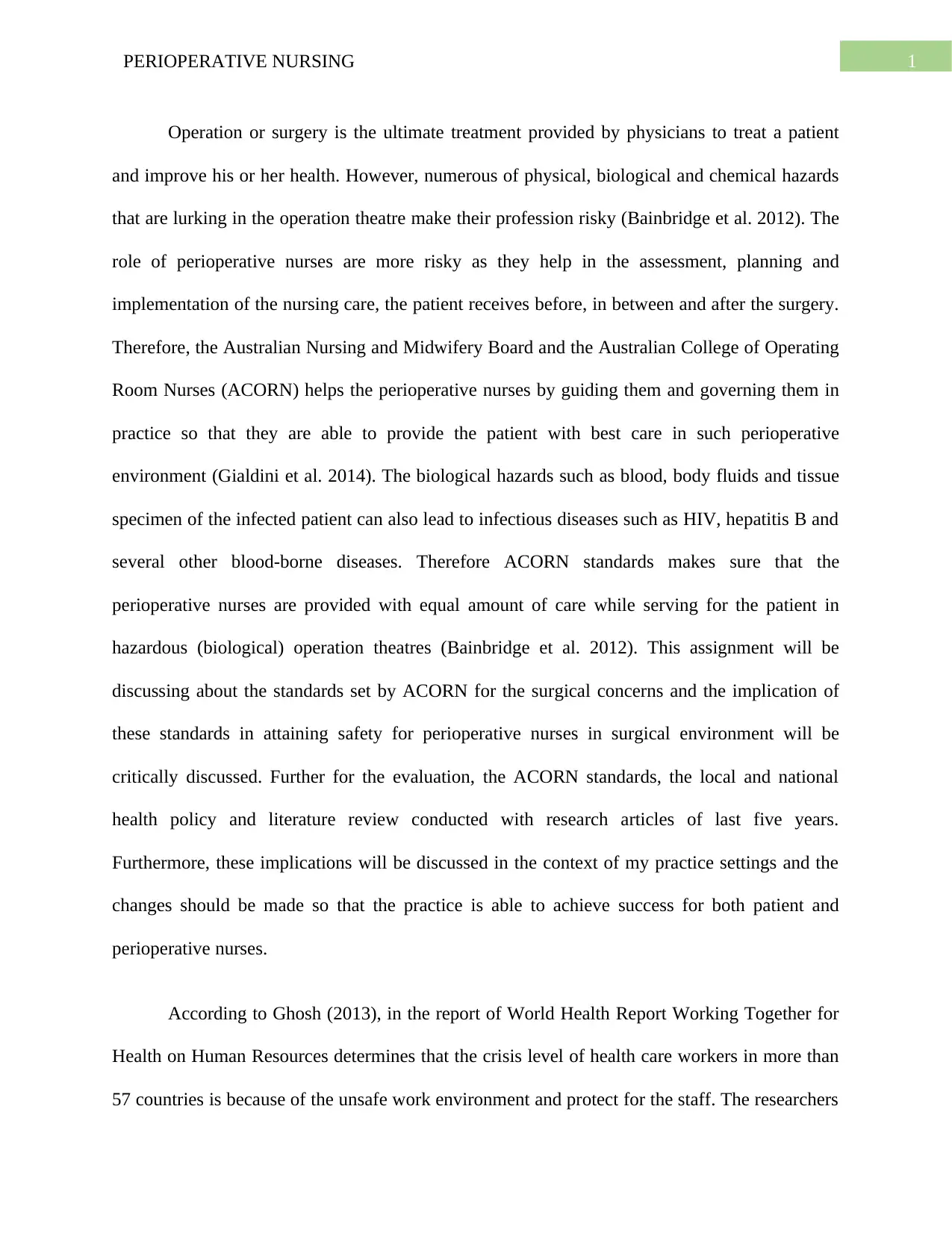
1PERIOPERATIVE NURSING
Operation or surgery is the ultimate treatment provided by physicians to treat a patient
and improve his or her health. However, numerous of physical, biological and chemical hazards
that are lurking in the operation theatre make their profession risky (Bainbridge et al. 2012). The
role of perioperative nurses are more risky as they help in the assessment, planning and
implementation of the nursing care, the patient receives before, in between and after the surgery.
Therefore, the Australian Nursing and Midwifery Board and the Australian College of Operating
Room Nurses (ACORN) helps the perioperative nurses by guiding them and governing them in
practice so that they are able to provide the patient with best care in such perioperative
environment (Gialdini et al. 2014). The biological hazards such as blood, body fluids and tissue
specimen of the infected patient can also lead to infectious diseases such as HIV, hepatitis B and
several other blood-borne diseases. Therefore ACORN standards makes sure that the
perioperative nurses are provided with equal amount of care while serving for the patient in
hazardous (biological) operation theatres (Bainbridge et al. 2012). This assignment will be
discussing about the standards set by ACORN for the surgical concerns and the implication of
these standards in attaining safety for perioperative nurses in surgical environment will be
critically discussed. Further for the evaluation, the ACORN standards, the local and national
health policy and literature review conducted with research articles of last five years.
Furthermore, these implications will be discussed in the context of my practice settings and the
changes should be made so that the practice is able to achieve success for both patient and
perioperative nurses.
According to Ghosh (2013), in the report of World Health Report Working Together for
Health on Human Resources determines that the crisis level of health care workers in more than
57 countries is because of the unsafe work environment and protect for the staff. The researchers
Operation or surgery is the ultimate treatment provided by physicians to treat a patient
and improve his or her health. However, numerous of physical, biological and chemical hazards
that are lurking in the operation theatre make their profession risky (Bainbridge et al. 2012). The
role of perioperative nurses are more risky as they help in the assessment, planning and
implementation of the nursing care, the patient receives before, in between and after the surgery.
Therefore, the Australian Nursing and Midwifery Board and the Australian College of Operating
Room Nurses (ACORN) helps the perioperative nurses by guiding them and governing them in
practice so that they are able to provide the patient with best care in such perioperative
environment (Gialdini et al. 2014). The biological hazards such as blood, body fluids and tissue
specimen of the infected patient can also lead to infectious diseases such as HIV, hepatitis B and
several other blood-borne diseases. Therefore ACORN standards makes sure that the
perioperative nurses are provided with equal amount of care while serving for the patient in
hazardous (biological) operation theatres (Bainbridge et al. 2012). This assignment will be
discussing about the standards set by ACORN for the surgical concerns and the implication of
these standards in attaining safety for perioperative nurses in surgical environment will be
critically discussed. Further for the evaluation, the ACORN standards, the local and national
health policy and literature review conducted with research articles of last five years.
Furthermore, these implications will be discussed in the context of my practice settings and the
changes should be made so that the practice is able to achieve success for both patient and
perioperative nurses.
According to Ghosh (2013), in the report of World Health Report Working Together for
Health on Human Resources determines that the crisis level of health care workers in more than
57 countries is because of the unsafe work environment and protect for the staff. The researchers
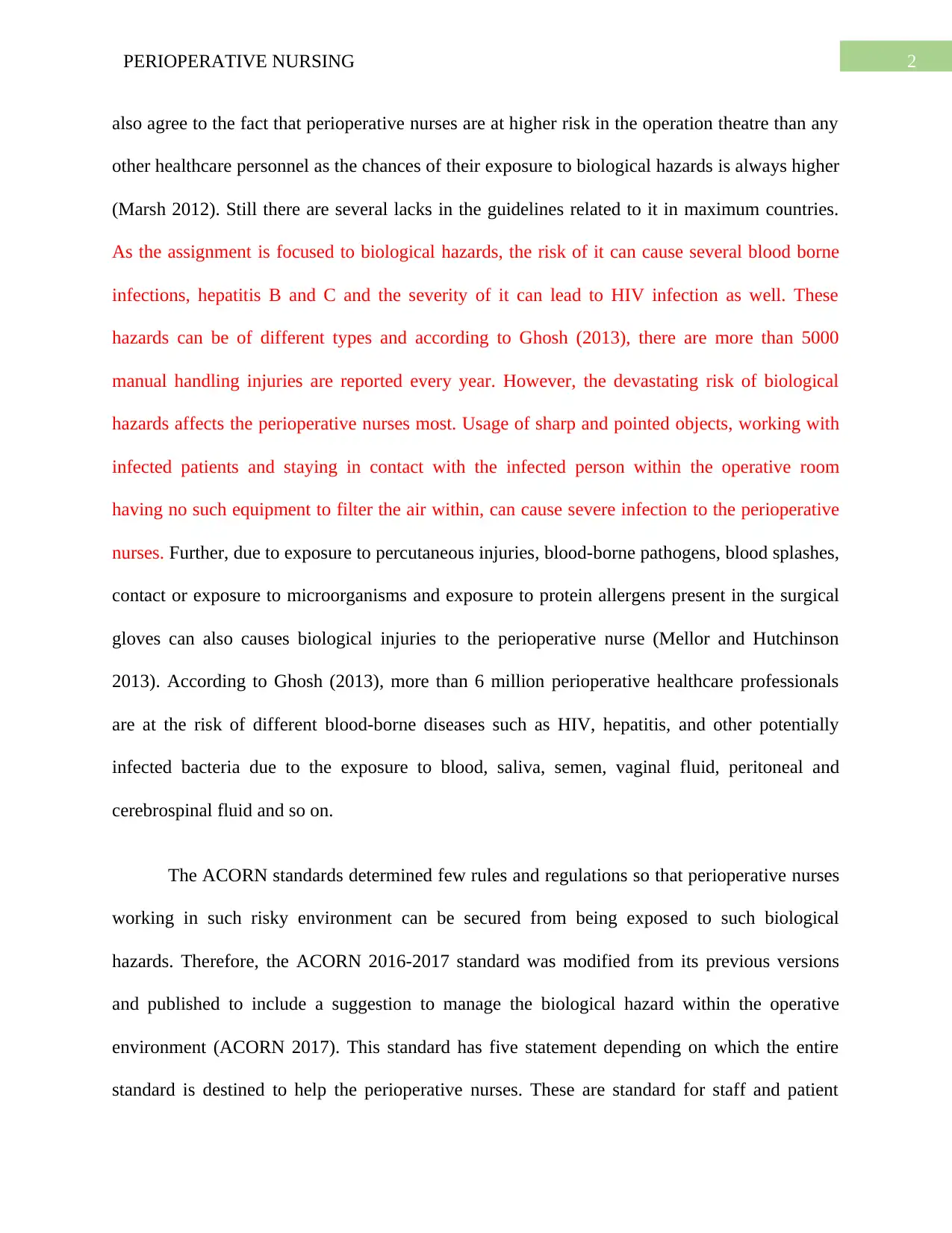
2PERIOPERATIVE NURSING
also agree to the fact that perioperative nurses are at higher risk in the operation theatre than any
other healthcare personnel as the chances of their exposure to biological hazards is always higher
(Marsh 2012). Still there are several lacks in the guidelines related to it in maximum countries.
As the assignment is focused to biological hazards, the risk of it can cause several blood borne
infections, hepatitis B and C and the severity of it can lead to HIV infection as well. These
hazards can be of different types and according to Ghosh (2013), there are more than 5000
manual handling injuries are reported every year. However, the devastating risk of biological
hazards affects the perioperative nurses most. Usage of sharp and pointed objects, working with
infected patients and staying in contact with the infected person within the operative room
having no such equipment to filter the air within, can cause severe infection to the perioperative
nurses. Further, due to exposure to percutaneous injuries, blood-borne pathogens, blood splashes,
contact or exposure to microorganisms and exposure to protein allergens present in the surgical
gloves can also causes biological injuries to the perioperative nurse (Mellor and Hutchinson
2013). According to Ghosh (2013), more than 6 million perioperative healthcare professionals
are at the risk of different blood-borne diseases such as HIV, hepatitis, and other potentially
infected bacteria due to the exposure to blood, saliva, semen, vaginal fluid, peritoneal and
cerebrospinal fluid and so on.
The ACORN standards determined few rules and regulations so that perioperative nurses
working in such risky environment can be secured from being exposed to such biological
hazards. Therefore, the ACORN 2016-2017 standard was modified from its previous versions
and published to include a suggestion to manage the biological hazard within the operative
environment (ACORN 2017). This standard has five statement depending on which the entire
standard is destined to help the perioperative nurses. These are standard for staff and patient
also agree to the fact that perioperative nurses are at higher risk in the operation theatre than any
other healthcare personnel as the chances of their exposure to biological hazards is always higher
(Marsh 2012). Still there are several lacks in the guidelines related to it in maximum countries.
As the assignment is focused to biological hazards, the risk of it can cause several blood borne
infections, hepatitis B and C and the severity of it can lead to HIV infection as well. These
hazards can be of different types and according to Ghosh (2013), there are more than 5000
manual handling injuries are reported every year. However, the devastating risk of biological
hazards affects the perioperative nurses most. Usage of sharp and pointed objects, working with
infected patients and staying in contact with the infected person within the operative room
having no such equipment to filter the air within, can cause severe infection to the perioperative
nurses. Further, due to exposure to percutaneous injuries, blood-borne pathogens, blood splashes,
contact or exposure to microorganisms and exposure to protein allergens present in the surgical
gloves can also causes biological injuries to the perioperative nurse (Mellor and Hutchinson
2013). According to Ghosh (2013), more than 6 million perioperative healthcare professionals
are at the risk of different blood-borne diseases such as HIV, hepatitis, and other potentially
infected bacteria due to the exposure to blood, saliva, semen, vaginal fluid, peritoneal and
cerebrospinal fluid and so on.
The ACORN standards determined few rules and regulations so that perioperative nurses
working in such risky environment can be secured from being exposed to such biological
hazards. Therefore, the ACORN 2016-2017 standard was modified from its previous versions
and published to include a suggestion to manage the biological hazard within the operative
environment (ACORN 2017). This standard has five statement depending on which the entire
standard is destined to help the perioperative nurses. These are standard for staff and patient
⊘ This is a preview!⊘
Do you want full access?
Subscribe today to unlock all pages.

Trusted by 1+ million students worldwide
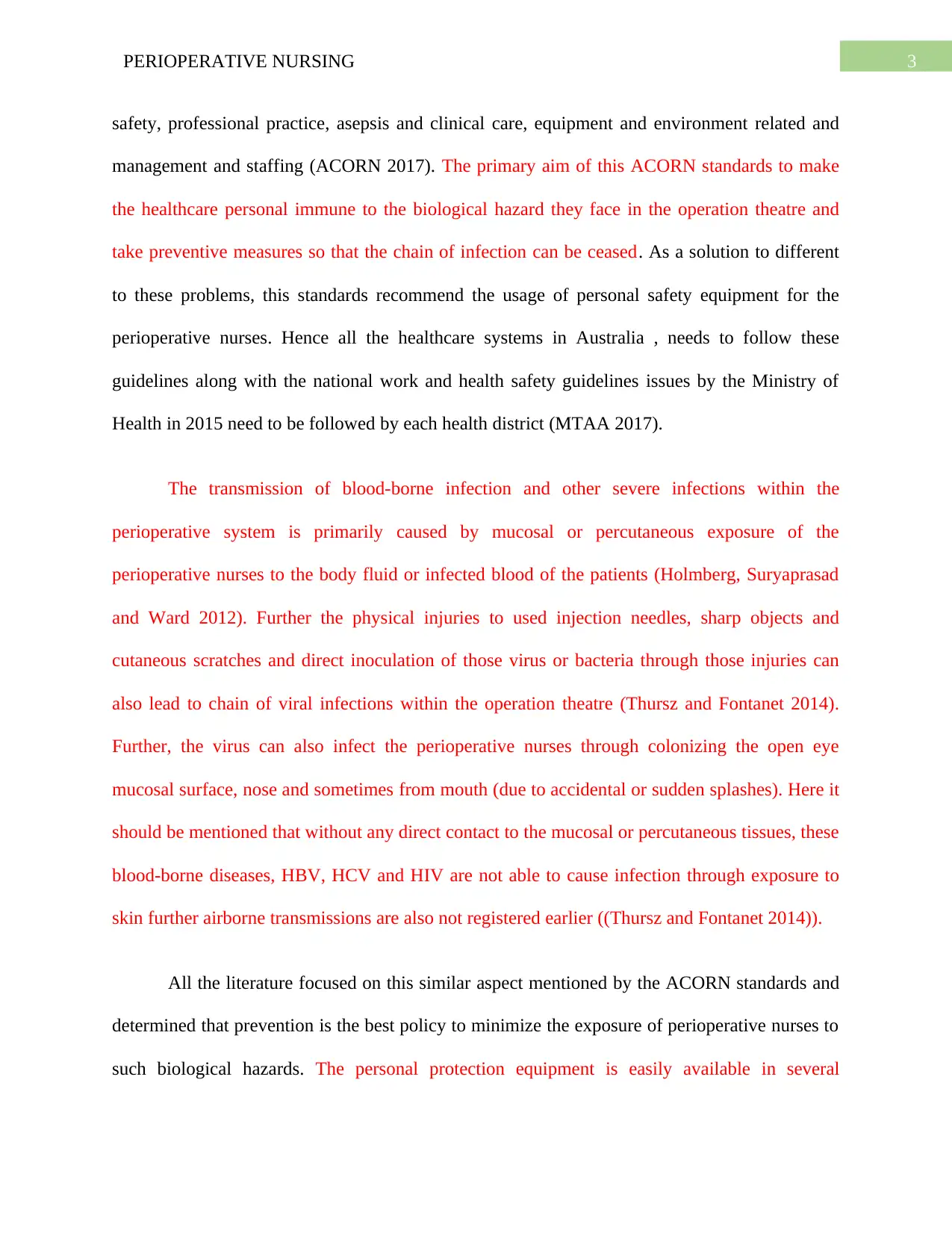
3PERIOPERATIVE NURSING
safety, professional practice, asepsis and clinical care, equipment and environment related and
management and staffing (ACORN 2017). The primary aim of this ACORN standards to make
the healthcare personal immune to the biological hazard they face in the operation theatre and
take preventive measures so that the chain of infection can be ceased. As a solution to different
to these problems, this standards recommend the usage of personal safety equipment for the
perioperative nurses. Hence all the healthcare systems in Australia , needs to follow these
guidelines along with the national work and health safety guidelines issues by the Ministry of
Health in 2015 need to be followed by each health district (MTAA 2017).
The transmission of blood-borne infection and other severe infections within the
perioperative system is primarily caused by mucosal or percutaneous exposure of the
perioperative nurses to the body fluid or infected blood of the patients (Holmberg, Suryaprasad
and Ward 2012). Further the physical injuries to used injection needles, sharp objects and
cutaneous scratches and direct inoculation of those virus or bacteria through those injuries can
also lead to chain of viral infections within the operation theatre (Thursz and Fontanet 2014).
Further, the virus can also infect the perioperative nurses through colonizing the open eye
mucosal surface, nose and sometimes from mouth (due to accidental or sudden splashes). Here it
should be mentioned that without any direct contact to the mucosal or percutaneous tissues, these
blood-borne diseases, HBV, HCV and HIV are not able to cause infection through exposure to
skin further airborne transmissions are also not registered earlier ((Thursz and Fontanet 2014)).
All the literature focused on this similar aspect mentioned by the ACORN standards and
determined that prevention is the best policy to minimize the exposure of perioperative nurses to
such biological hazards. The personal protection equipment is easily available in several
safety, professional practice, asepsis and clinical care, equipment and environment related and
management and staffing (ACORN 2017). The primary aim of this ACORN standards to make
the healthcare personal immune to the biological hazard they face in the operation theatre and
take preventive measures so that the chain of infection can be ceased. As a solution to different
to these problems, this standards recommend the usage of personal safety equipment for the
perioperative nurses. Hence all the healthcare systems in Australia , needs to follow these
guidelines along with the national work and health safety guidelines issues by the Ministry of
Health in 2015 need to be followed by each health district (MTAA 2017).
The transmission of blood-borne infection and other severe infections within the
perioperative system is primarily caused by mucosal or percutaneous exposure of the
perioperative nurses to the body fluid or infected blood of the patients (Holmberg, Suryaprasad
and Ward 2012). Further the physical injuries to used injection needles, sharp objects and
cutaneous scratches and direct inoculation of those virus or bacteria through those injuries can
also lead to chain of viral infections within the operation theatre (Thursz and Fontanet 2014).
Further, the virus can also infect the perioperative nurses through colonizing the open eye
mucosal surface, nose and sometimes from mouth (due to accidental or sudden splashes). Here it
should be mentioned that without any direct contact to the mucosal or percutaneous tissues, these
blood-borne diseases, HBV, HCV and HIV are not able to cause infection through exposure to
skin further airborne transmissions are also not registered earlier ((Thursz and Fontanet 2014)).
All the literature focused on this similar aspect mentioned by the ACORN standards and
determined that prevention is the best policy to minimize the exposure of perioperative nurses to
such biological hazards. The personal protection equipment is easily available in several
Paraphrase This Document
Need a fresh take? Get an instant paraphrase of this document with our AI Paraphraser
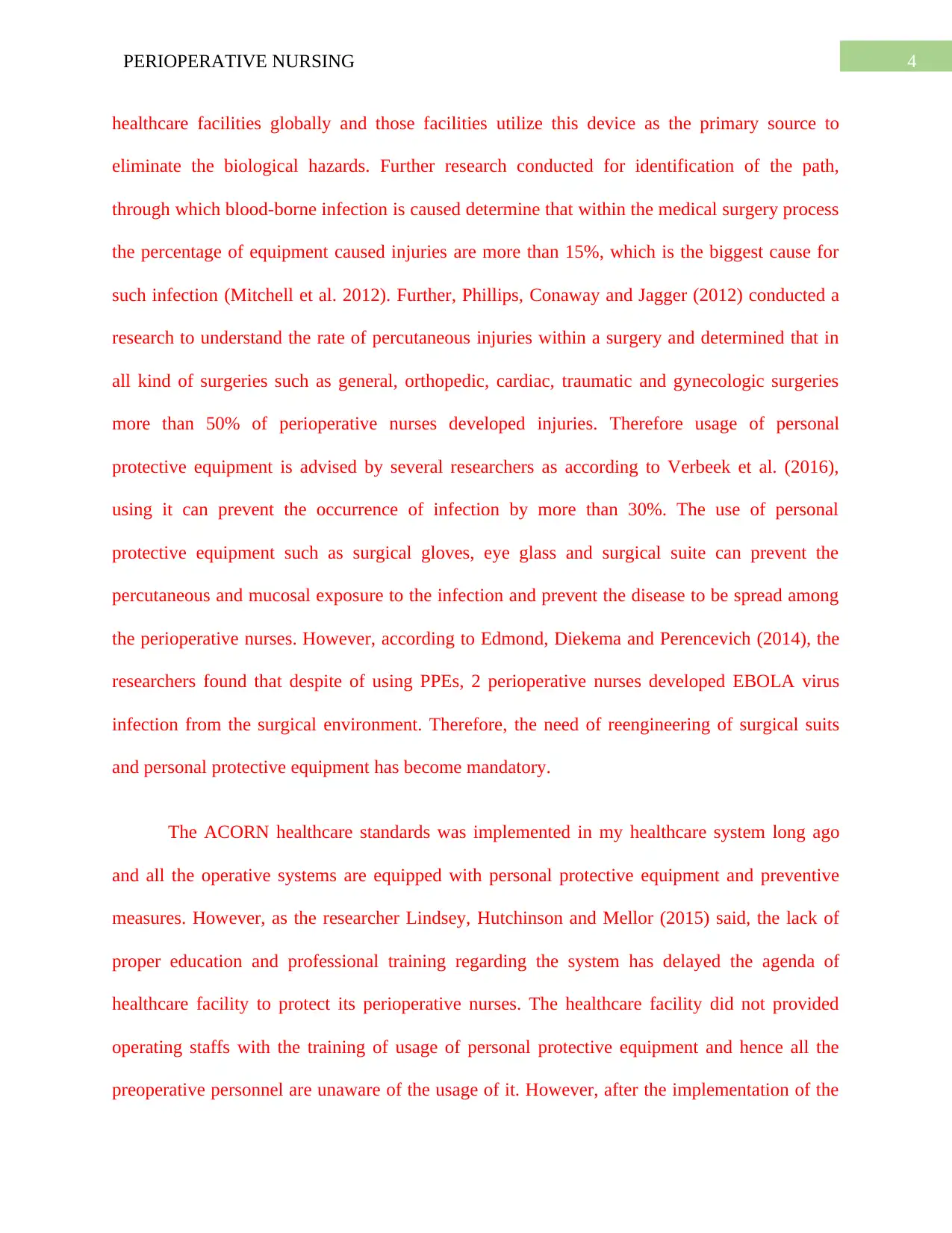
4PERIOPERATIVE NURSING
healthcare facilities globally and those facilities utilize this device as the primary source to
eliminate the biological hazards. Further research conducted for identification of the path,
through which blood-borne infection is caused determine that within the medical surgery process
the percentage of equipment caused injuries are more than 15%, which is the biggest cause for
such infection (Mitchell et al. 2012). Further, Phillips, Conaway and Jagger (2012) conducted a
research to understand the rate of percutaneous injuries within a surgery and determined that in
all kind of surgeries such as general, orthopedic, cardiac, traumatic and gynecologic surgeries
more than 50% of perioperative nurses developed injuries. Therefore usage of personal
protective equipment is advised by several researchers as according to Verbeek et al. (2016),
using it can prevent the occurrence of infection by more than 30%. The use of personal
protective equipment such as surgical gloves, eye glass and surgical suite can prevent the
percutaneous and mucosal exposure to the infection and prevent the disease to be spread among
the perioperative nurses. However, according to Edmond, Diekema and Perencevich (2014), the
researchers found that despite of using PPEs, 2 perioperative nurses developed EBOLA virus
infection from the surgical environment. Therefore, the need of reengineering of surgical suits
and personal protective equipment has become mandatory.
The ACORN healthcare standards was implemented in my healthcare system long ago
and all the operative systems are equipped with personal protective equipment and preventive
measures. However, as the researcher Lindsey, Hutchinson and Mellor (2015) said, the lack of
proper education and professional training regarding the system has delayed the agenda of
healthcare facility to protect its perioperative nurses. The healthcare facility did not provided
operating staffs with the training of usage of personal protective equipment and hence all the
preoperative personnel are unaware of the usage of it. However, after the implementation of the
healthcare facilities globally and those facilities utilize this device as the primary source to
eliminate the biological hazards. Further research conducted for identification of the path,
through which blood-borne infection is caused determine that within the medical surgery process
the percentage of equipment caused injuries are more than 15%, which is the biggest cause for
such infection (Mitchell et al. 2012). Further, Phillips, Conaway and Jagger (2012) conducted a
research to understand the rate of percutaneous injuries within a surgery and determined that in
all kind of surgeries such as general, orthopedic, cardiac, traumatic and gynecologic surgeries
more than 50% of perioperative nurses developed injuries. Therefore usage of personal
protective equipment is advised by several researchers as according to Verbeek et al. (2016),
using it can prevent the occurrence of infection by more than 30%. The use of personal
protective equipment such as surgical gloves, eye glass and surgical suite can prevent the
percutaneous and mucosal exposure to the infection and prevent the disease to be spread among
the perioperative nurses. However, according to Edmond, Diekema and Perencevich (2014), the
researchers found that despite of using PPEs, 2 perioperative nurses developed EBOLA virus
infection from the surgical environment. Therefore, the need of reengineering of surgical suits
and personal protective equipment has become mandatory.
The ACORN healthcare standards was implemented in my healthcare system long ago
and all the operative systems are equipped with personal protective equipment and preventive
measures. However, as the researcher Lindsey, Hutchinson and Mellor (2015) said, the lack of
proper education and professional training regarding the system has delayed the agenda of
healthcare facility to protect its perioperative nurses. The healthcare facility did not provided
operating staffs with the training of usage of personal protective equipment and hence all the
preoperative personnel are unaware of the usage of it. However, after the implementation of the
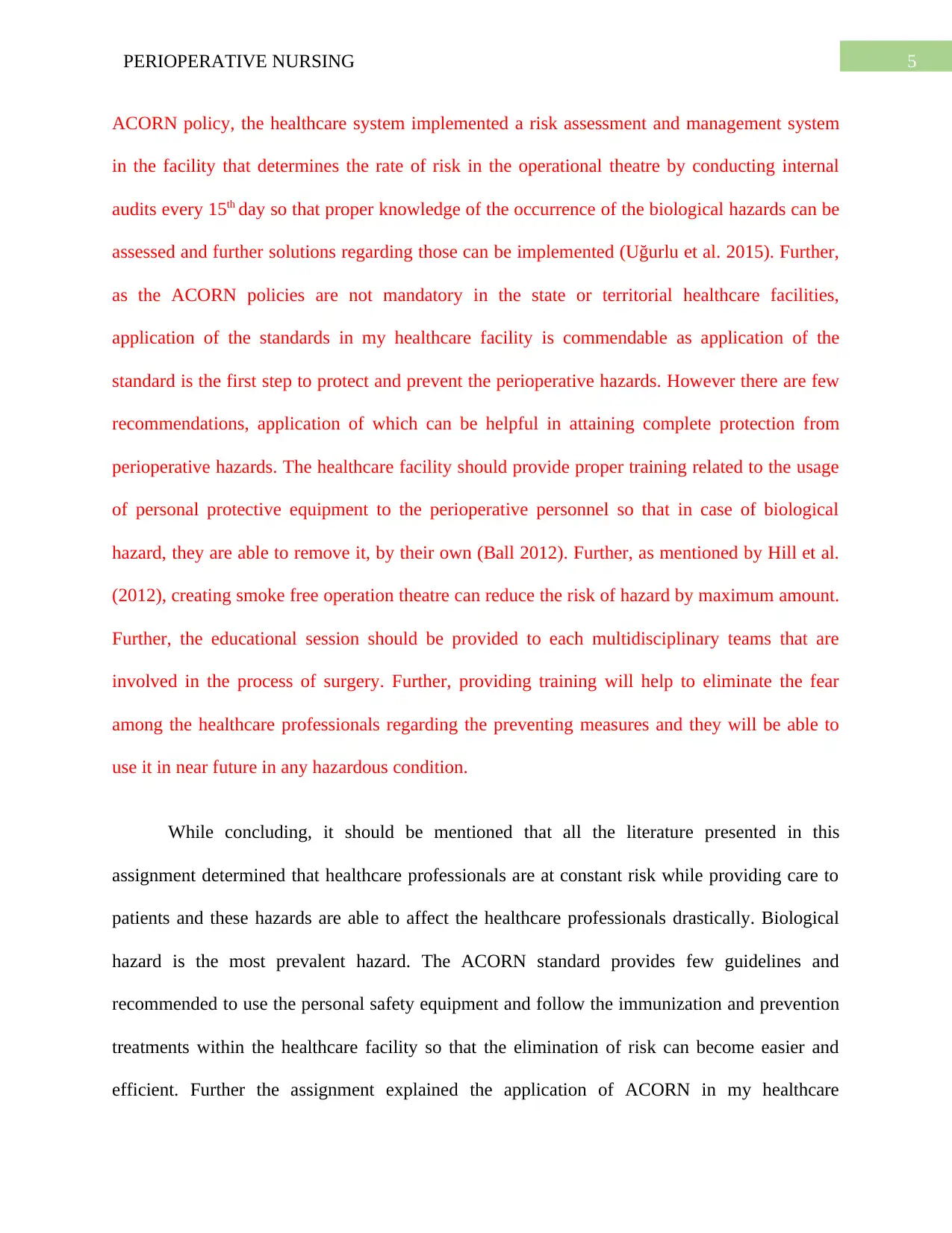
5PERIOPERATIVE NURSING
ACORN policy, the healthcare system implemented a risk assessment and management system
in the facility that determines the rate of risk in the operational theatre by conducting internal
audits every 15th day so that proper knowledge of the occurrence of the biological hazards can be
assessed and further solutions regarding those can be implemented (Uğurlu et al. 2015). Further,
as the ACORN policies are not mandatory in the state or territorial healthcare facilities,
application of the standards in my healthcare facility is commendable as application of the
standard is the first step to protect and prevent the perioperative hazards. However there are few
recommendations, application of which can be helpful in attaining complete protection from
perioperative hazards. The healthcare facility should provide proper training related to the usage
of personal protective equipment to the perioperative personnel so that in case of biological
hazard, they are able to remove it, by their own (Ball 2012). Further, as mentioned by Hill et al.
(2012), creating smoke free operation theatre can reduce the risk of hazard by maximum amount.
Further, the educational session should be provided to each multidisciplinary teams that are
involved in the process of surgery. Further, providing training will help to eliminate the fear
among the healthcare professionals regarding the preventing measures and they will be able to
use it in near future in any hazardous condition.
While concluding, it should be mentioned that all the literature presented in this
assignment determined that healthcare professionals are at constant risk while providing care to
patients and these hazards are able to affect the healthcare professionals drastically. Biological
hazard is the most prevalent hazard. The ACORN standard provides few guidelines and
recommended to use the personal safety equipment and follow the immunization and prevention
treatments within the healthcare facility so that the elimination of risk can become easier and
efficient. Further the assignment explained the application of ACORN in my healthcare
ACORN policy, the healthcare system implemented a risk assessment and management system
in the facility that determines the rate of risk in the operational theatre by conducting internal
audits every 15th day so that proper knowledge of the occurrence of the biological hazards can be
assessed and further solutions regarding those can be implemented (Uğurlu et al. 2015). Further,
as the ACORN policies are not mandatory in the state or territorial healthcare facilities,
application of the standards in my healthcare facility is commendable as application of the
standard is the first step to protect and prevent the perioperative hazards. However there are few
recommendations, application of which can be helpful in attaining complete protection from
perioperative hazards. The healthcare facility should provide proper training related to the usage
of personal protective equipment to the perioperative personnel so that in case of biological
hazard, they are able to remove it, by their own (Ball 2012). Further, as mentioned by Hill et al.
(2012), creating smoke free operation theatre can reduce the risk of hazard by maximum amount.
Further, the educational session should be provided to each multidisciplinary teams that are
involved in the process of surgery. Further, providing training will help to eliminate the fear
among the healthcare professionals regarding the preventing measures and they will be able to
use it in near future in any hazardous condition.
While concluding, it should be mentioned that all the literature presented in this
assignment determined that healthcare professionals are at constant risk while providing care to
patients and these hazards are able to affect the healthcare professionals drastically. Biological
hazard is the most prevalent hazard. The ACORN standard provides few guidelines and
recommended to use the personal safety equipment and follow the immunization and prevention
treatments within the healthcare facility so that the elimination of risk can become easier and
efficient. Further the assignment explained the application of ACORN in my healthcare
⊘ This is a preview!⊘
Do you want full access?
Subscribe today to unlock all pages.

Trusted by 1+ million students worldwide
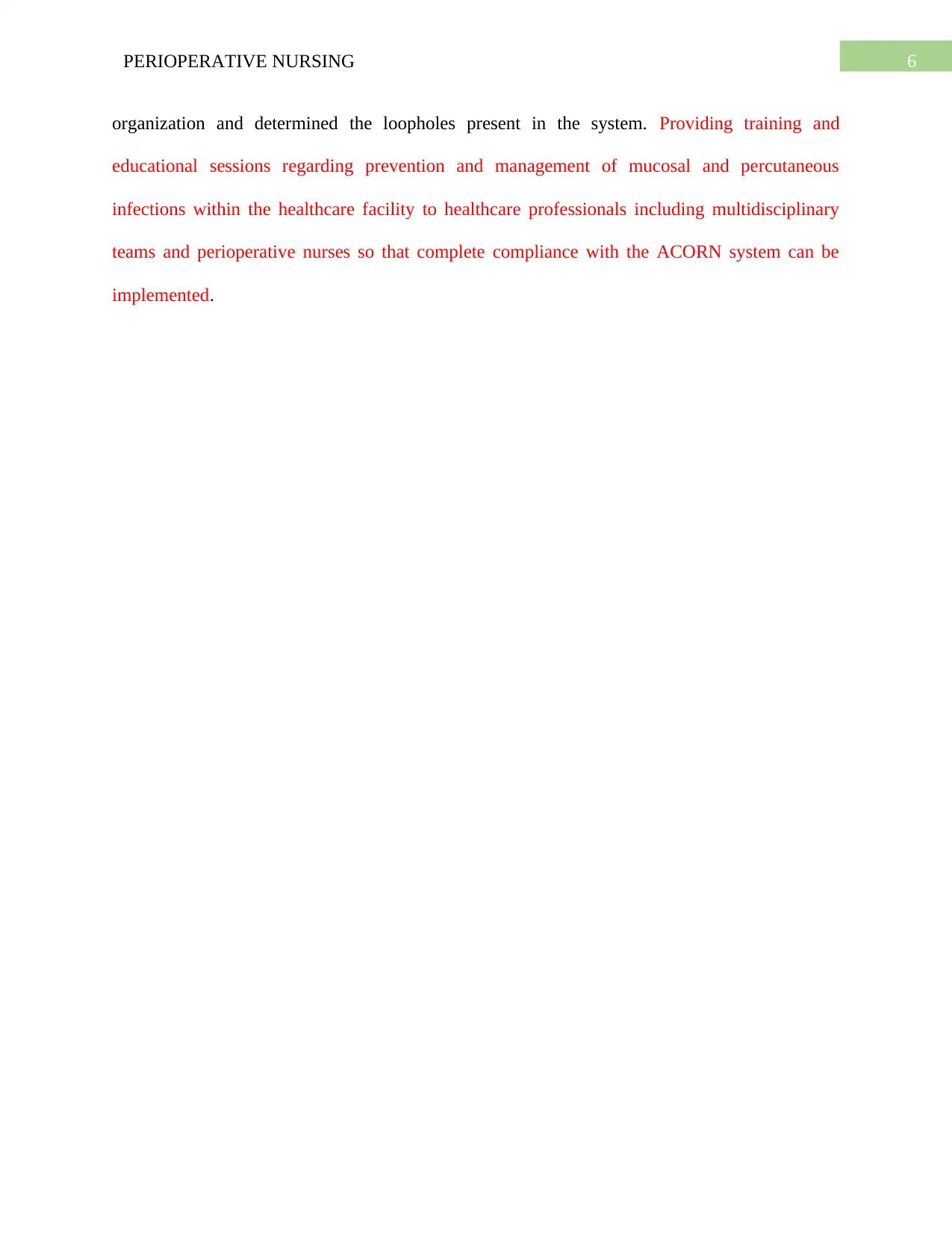
6PERIOPERATIVE NURSING
organization and determined the loopholes present in the system. Providing training and
educational sessions regarding prevention and management of mucosal and percutaneous
infections within the healthcare facility to healthcare professionals including multidisciplinary
teams and perioperative nurses so that complete compliance with the ACORN system can be
implemented.
organization and determined the loopholes present in the system. Providing training and
educational sessions regarding prevention and management of mucosal and percutaneous
infections within the healthcare facility to healthcare professionals including multidisciplinary
teams and perioperative nurses so that complete compliance with the ACORN system can be
implemented.
Paraphrase This Document
Need a fresh take? Get an instant paraphrase of this document with our AI Paraphraser
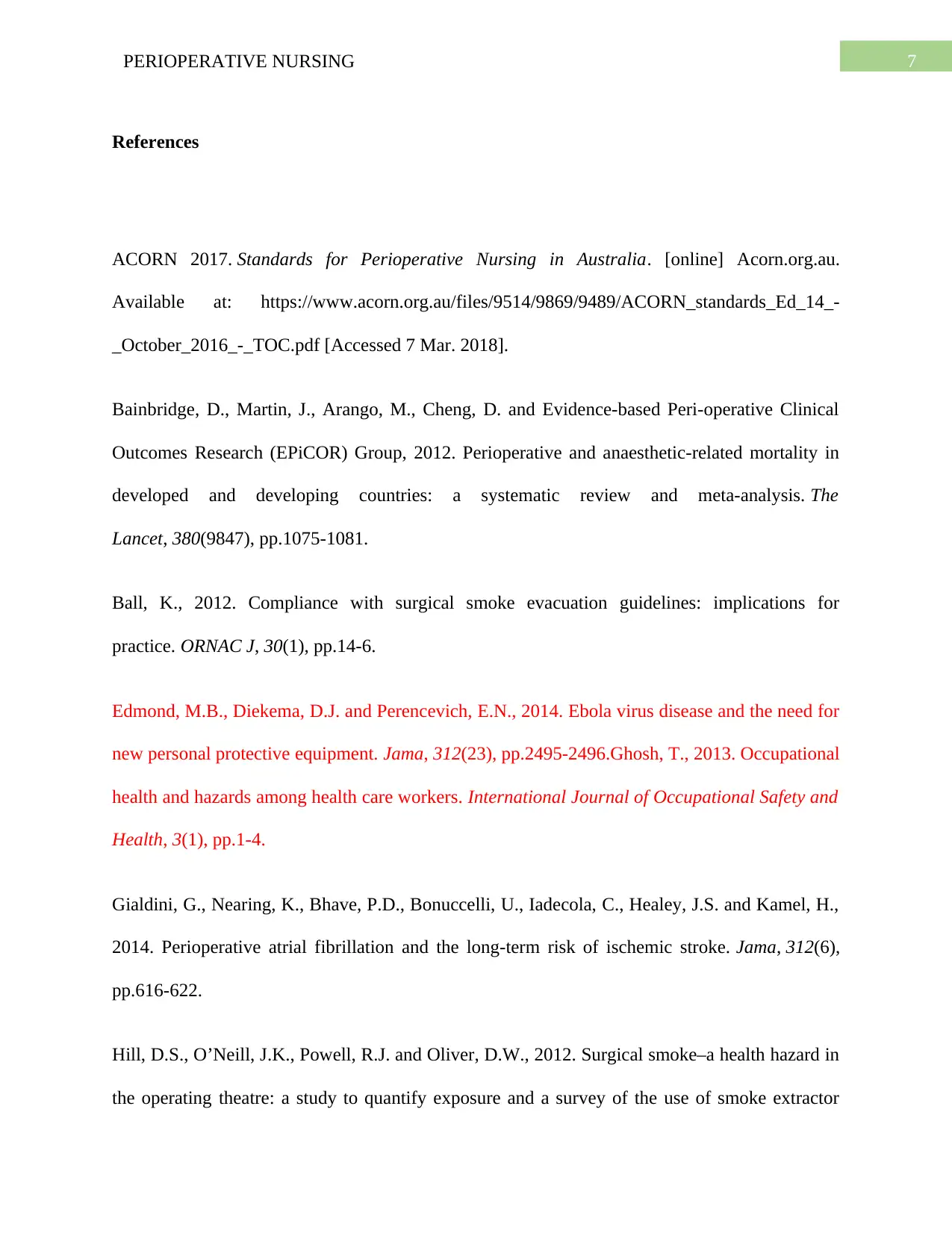
7PERIOPERATIVE NURSING
References
ACORN 2017. Standards for Perioperative Nursing in Australia. [online] Acorn.org.au.
Available at: https://www.acorn.org.au/files/9514/9869/9489/ACORN_standards_Ed_14_-
_October_2016_-_TOC.pdf [Accessed 7 Mar. 2018].
Bainbridge, D., Martin, J., Arango, M., Cheng, D. and Evidence-based Peri-operative Clinical
Outcomes Research (EPiCOR) Group, 2012. Perioperative and anaesthetic-related mortality in
developed and developing countries: a systematic review and meta-analysis. The
Lancet, 380(9847), pp.1075-1081.
Ball, K., 2012. Compliance with surgical smoke evacuation guidelines: implications for
practice. ORNAC J, 30(1), pp.14-6.
Edmond, M.B., Diekema, D.J. and Perencevich, E.N., 2014. Ebola virus disease and the need for
new personal protective equipment. Jama, 312(23), pp.2495-2496.Ghosh, T., 2013. Occupational
health and hazards among health care workers. International Journal of Occupational Safety and
Health, 3(1), pp.1-4.
Gialdini, G., Nearing, K., Bhave, P.D., Bonuccelli, U., Iadecola, C., Healey, J.S. and Kamel, H.,
2014. Perioperative atrial fibrillation and the long-term risk of ischemic stroke. Jama, 312(6),
pp.616-622.
Hill, D.S., O’Neill, J.K., Powell, R.J. and Oliver, D.W., 2012. Surgical smoke–a health hazard in
the operating theatre: a study to quantify exposure and a survey of the use of smoke extractor
References
ACORN 2017. Standards for Perioperative Nursing in Australia. [online] Acorn.org.au.
Available at: https://www.acorn.org.au/files/9514/9869/9489/ACORN_standards_Ed_14_-
_October_2016_-_TOC.pdf [Accessed 7 Mar. 2018].
Bainbridge, D., Martin, J., Arango, M., Cheng, D. and Evidence-based Peri-operative Clinical
Outcomes Research (EPiCOR) Group, 2012. Perioperative and anaesthetic-related mortality in
developed and developing countries: a systematic review and meta-analysis. The
Lancet, 380(9847), pp.1075-1081.
Ball, K., 2012. Compliance with surgical smoke evacuation guidelines: implications for
practice. ORNAC J, 30(1), pp.14-6.
Edmond, M.B., Diekema, D.J. and Perencevich, E.N., 2014. Ebola virus disease and the need for
new personal protective equipment. Jama, 312(23), pp.2495-2496.Ghosh, T., 2013. Occupational
health and hazards among health care workers. International Journal of Occupational Safety and
Health, 3(1), pp.1-4.
Gialdini, G., Nearing, K., Bhave, P.D., Bonuccelli, U., Iadecola, C., Healey, J.S. and Kamel, H.,
2014. Perioperative atrial fibrillation and the long-term risk of ischemic stroke. Jama, 312(6),
pp.616-622.
Hill, D.S., O’Neill, J.K., Powell, R.J. and Oliver, D.W., 2012. Surgical smoke–a health hazard in
the operating theatre: a study to quantify exposure and a survey of the use of smoke extractor
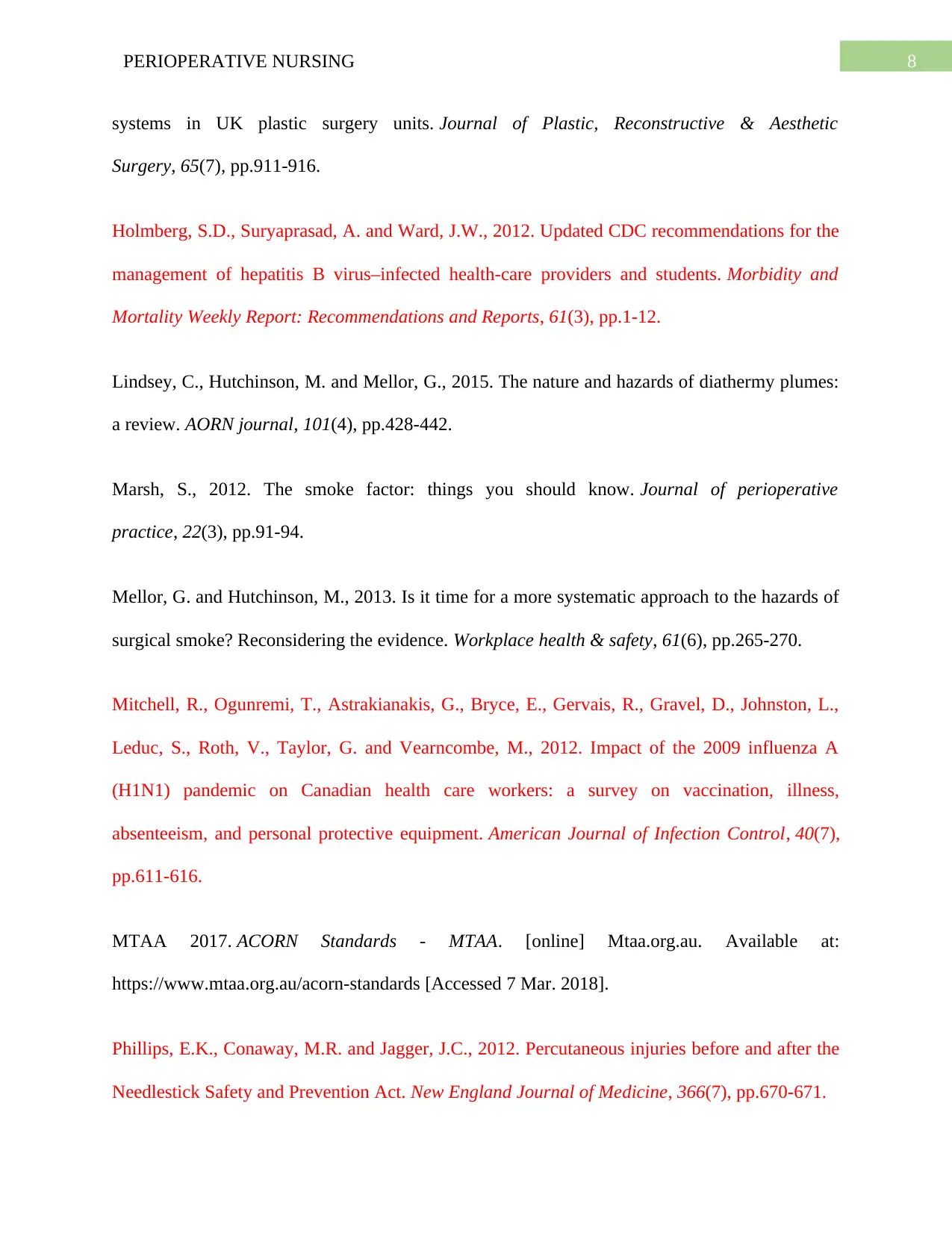
8PERIOPERATIVE NURSING
systems in UK plastic surgery units. Journal of Plastic, Reconstructive & Aesthetic
Surgery, 65(7), pp.911-916.
Holmberg, S.D., Suryaprasad, A. and Ward, J.W., 2012. Updated CDC recommendations for the
management of hepatitis B virus–infected health-care providers and students. Morbidity and
Mortality Weekly Report: Recommendations and Reports, 61(3), pp.1-12.
Lindsey, C., Hutchinson, M. and Mellor, G., 2015. The nature and hazards of diathermy plumes:
a review. AORN journal, 101(4), pp.428-442.
Marsh, S., 2012. The smoke factor: things you should know. Journal of perioperative
practice, 22(3), pp.91-94.
Mellor, G. and Hutchinson, M., 2013. Is it time for a more systematic approach to the hazards of
surgical smoke? Reconsidering the evidence. Workplace health & safety, 61(6), pp.265-270.
Mitchell, R., Ogunremi, T., Astrakianakis, G., Bryce, E., Gervais, R., Gravel, D., Johnston, L.,
Leduc, S., Roth, V., Taylor, G. and Vearncombe, M., 2012. Impact of the 2009 influenza A
(H1N1) pandemic on Canadian health care workers: a survey on vaccination, illness,
absenteeism, and personal protective equipment. American Journal of Infection Control, 40(7),
pp.611-616.
MTAA 2017. ACORN Standards - MTAA. [online] Mtaa.org.au. Available at:
https://www.mtaa.org.au/acorn-standards [Accessed 7 Mar. 2018].
Phillips, E.K., Conaway, M.R. and Jagger, J.C., 2012. Percutaneous injuries before and after the
Needlestick Safety and Prevention Act. New England Journal of Medicine, 366(7), pp.670-671.
systems in UK plastic surgery units. Journal of Plastic, Reconstructive & Aesthetic
Surgery, 65(7), pp.911-916.
Holmberg, S.D., Suryaprasad, A. and Ward, J.W., 2012. Updated CDC recommendations for the
management of hepatitis B virus–infected health-care providers and students. Morbidity and
Mortality Weekly Report: Recommendations and Reports, 61(3), pp.1-12.
Lindsey, C., Hutchinson, M. and Mellor, G., 2015. The nature and hazards of diathermy plumes:
a review. AORN journal, 101(4), pp.428-442.
Marsh, S., 2012. The smoke factor: things you should know. Journal of perioperative
practice, 22(3), pp.91-94.
Mellor, G. and Hutchinson, M., 2013. Is it time for a more systematic approach to the hazards of
surgical smoke? Reconsidering the evidence. Workplace health & safety, 61(6), pp.265-270.
Mitchell, R., Ogunremi, T., Astrakianakis, G., Bryce, E., Gervais, R., Gravel, D., Johnston, L.,
Leduc, S., Roth, V., Taylor, G. and Vearncombe, M., 2012. Impact of the 2009 influenza A
(H1N1) pandemic on Canadian health care workers: a survey on vaccination, illness,
absenteeism, and personal protective equipment. American Journal of Infection Control, 40(7),
pp.611-616.
MTAA 2017. ACORN Standards - MTAA. [online] Mtaa.org.au. Available at:
https://www.mtaa.org.au/acorn-standards [Accessed 7 Mar. 2018].
Phillips, E.K., Conaway, M.R. and Jagger, J.C., 2012. Percutaneous injuries before and after the
Needlestick Safety and Prevention Act. New England Journal of Medicine, 366(7), pp.670-671.
⊘ This is a preview!⊘
Do you want full access?
Subscribe today to unlock all pages.

Trusted by 1+ million students worldwide
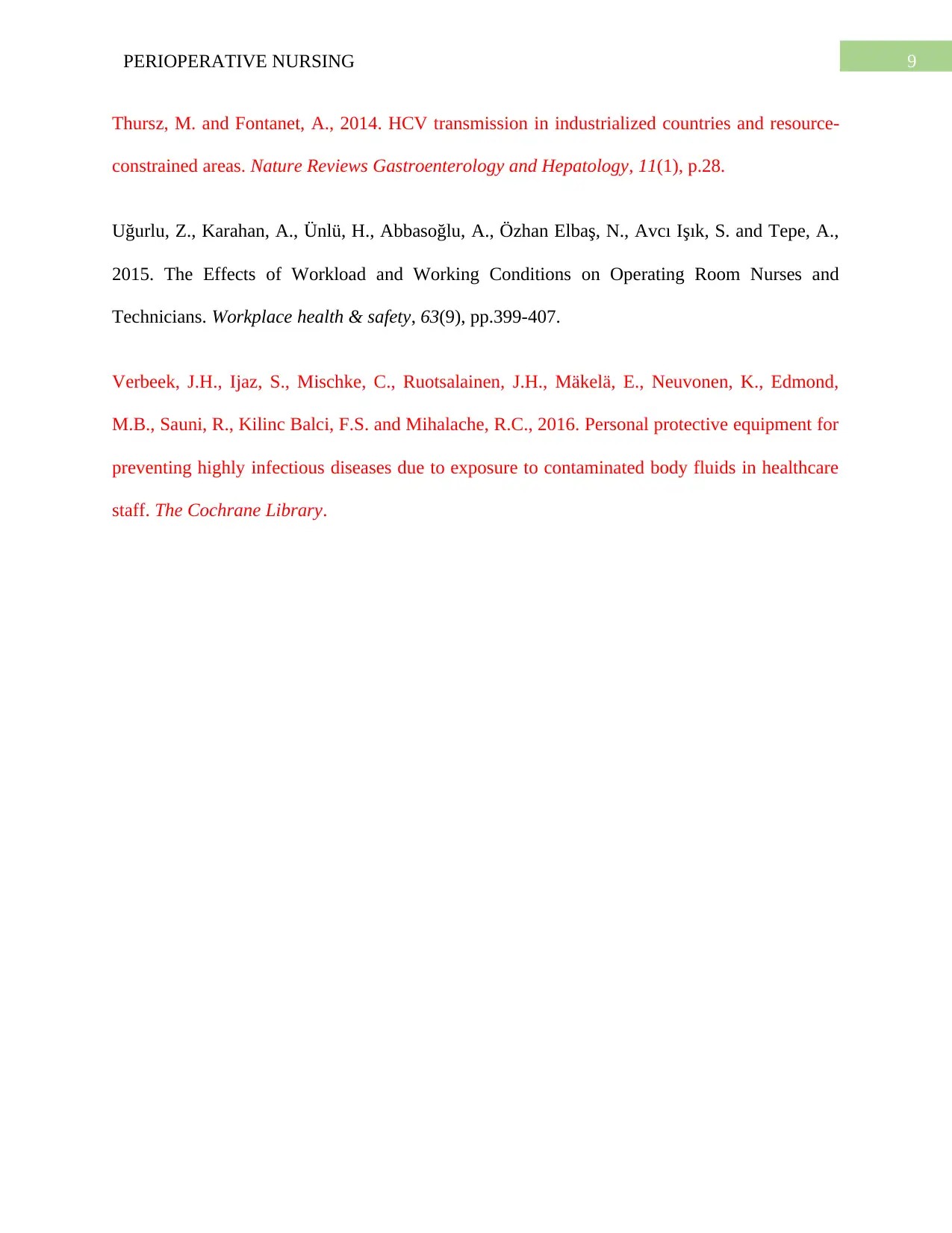
9PERIOPERATIVE NURSING
Thursz, M. and Fontanet, A., 2014. HCV transmission in industrialized countries and resource-
constrained areas. Nature Reviews Gastroenterology and Hepatology, 11(1), p.28.
Uğurlu, Z., Karahan, A., Ünlü, H., Abbasoğlu, A., Özhan Elbaş, N., Avcı Işık, S. and Tepe, A.,
2015. The Effects of Workload and Working Conditions on Operating Room Nurses and
Technicians. Workplace health & safety, 63(9), pp.399-407.
Verbeek, J.H., Ijaz, S., Mischke, C., Ruotsalainen, J.H., Mäkelä, E., Neuvonen, K., Edmond,
M.B., Sauni, R., Kilinc Balci, F.S. and Mihalache, R.C., 2016. Personal protective equipment for
preventing highly infectious diseases due to exposure to contaminated body fluids in healthcare
staff. The Cochrane Library.
Thursz, M. and Fontanet, A., 2014. HCV transmission in industrialized countries and resource-
constrained areas. Nature Reviews Gastroenterology and Hepatology, 11(1), p.28.
Uğurlu, Z., Karahan, A., Ünlü, H., Abbasoğlu, A., Özhan Elbaş, N., Avcı Işık, S. and Tepe, A.,
2015. The Effects of Workload and Working Conditions on Operating Room Nurses and
Technicians. Workplace health & safety, 63(9), pp.399-407.
Verbeek, J.H., Ijaz, S., Mischke, C., Ruotsalainen, J.H., Mäkelä, E., Neuvonen, K., Edmond,
M.B., Sauni, R., Kilinc Balci, F.S. and Mihalache, R.C., 2016. Personal protective equipment for
preventing highly infectious diseases due to exposure to contaminated body fluids in healthcare
staff. The Cochrane Library.
1 out of 10
Related Documents
Your All-in-One AI-Powered Toolkit for Academic Success.
+13062052269
info@desklib.com
Available 24*7 on WhatsApp / Email
![[object Object]](/_next/static/media/star-bottom.7253800d.svg)
Unlock your academic potential
Copyright © 2020–2025 A2Z Services. All Rights Reserved. Developed and managed by ZUCOL.





